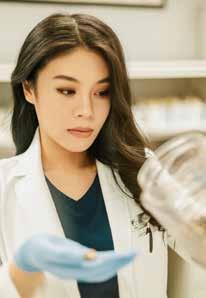
9 minute read
healing ways
Fending Off Fibroids
NATURAL APPROACHES OFFER RELIEF
Advertisement
by Marlaina Donato
Optimal reproductive health is key to our vitality, which is why living with uterine fibroids can be debilitating. Studies indicate that as many as 80 percent of American women develop these non-cancerous growths during their childbearing years. Oftentimes, the condition is free of symptoms, but an estimated 26 million women currently suffer from associated effects like chronic pelvic and back pain, frequent urination, excessive menstrual bleeding and a swollen abdomen. Also called myomas, fibroids can often be a hidden cause of infertility, even in asymptomatic cases.
Asian women have a lower incidence of fibroids, while African American women are two to three times more likely to develop them than white women, particularly at a younger age. Genetics, obesity, estrogen-promoting foods and environmental toxins can fuel the fire of this condition, but a tailored, natural approach can minimize symptoms and for some, ward off the need for invasive surgery.
Happier Hormones Through Diet
While there is no definitively known cause of fibroids, the most accepted theory is a disruption in the ratio between estrogen and progesterone. Italian researchers that examined data from 1990 to 2020 reported in the International Journal of Environmental Research and Public Health last year that diets deficient in fresh fruits, green vegetables and vitamin D increase the risk for the onset and formation of uterine fibroids.
“I do believe prevention is important by avoiding the use of toxic cosmetics and cookware with chemical components, and by choosing lower-inflammatory foods,” says Crystal Fedele, a doctor of Chinese medicine who treats patients with acupuncture and Chinese herbs at her clinic, Holistic Women and Families Natural Health Center, in Port Orange, Florida.
Conventionally farmed produce and farm-raised fish are treated with environmental estrogens to stimulate growth, which in turn contribute to estrogen dominance and an increased risk of fibroids in women that consume such foods. “It’s important to eliminate dairy and meat raised with synthetic hormones that can act like estrogen in the body,” advises Alisa Vitti, a New York City-based women’s hormone expert and author of In the FLO: Unlock Your Hormonal Advantage and Revolutionize Your Life. “While no diet can guarantee fibroid prevention, altering the food you eat may help slow fibroid growth. When it comes to food, your first step is to remove inflammatory foods.”
Vitti recommends opting for fiber-rich whole grains that aid in the elimination
of excess estrogen, as well as nixing gluten and all dairy products unless they are made from organic goat or sheep milk. “High insulin levels from white, starchy stuff—which acts like sugar in the body—is a factor in making fibroids grow,” she says.
Cruciferous vegetables like broccoli, kale and bok choy are allies in the fight against fibroids by boosting detoxifying enzymes in the liver. Regular servings of sweet potatoes, carrots, apricots, pumpkin, spinach and other carotene-rich foods are also valuable.
Ancient Healing Modalities
Traditional Chinese Medicine offers promising benefits, but when using recommended herbs, it’s important to seek out qualified practitioners rather than self-treat, advises Fedele. “In Chinese medicine, each case is individual, so herbal formulations are often constructed to treat the whole health of the person and modified as we see improvements,” she says. “We also use a lot of supplements that can help regulate hormones—DIM (diindolylmethane) and broccoli seed extract being two that are commonly used for estrogen-related disorders.” Fedele also recommends acupuncture, but says it is most effective when combined with herbals, supplements and dietary therapies.
Susannah Neal, a licensed acupuncturist in Iowa City, Iowa, concurs, saying, “Chinese medicine is highly effective for rebalancing the flow or energy and breaking up old patterns of imbalances.” Neal, certified in the Arvigo Techniques of Maya Abdominal Therapy, attests to this gentle modality designed to invigorate the circulatory, lymphatic and nervous systems of the digestive and reproductive organs. “Fibroids may be a result of impaired blood flow in the uterus, and while many styles of massage use techniques to improve circulation, these techniques focus
FOODS TO CONSUME FOR ACHIEVING HORMONE BALANCE
Almonds and hazelnuts Arugula Cold-water, deep-sea fish: salmon, tuna, herring, halibut, mackerel, sardines Garlic Green tea Organic wheat germ Radish Reishi mushrooms Turnips Vitamin E, vitamin B complex, magnesium, omega-3 fatty acids Watercress
specifically on the reproductive and pelvic organs,” she says.
According to Neal, one benefit of the Arvigo technique is regulation of the menstrual cycle. When applied regularly, the massage may reduce the size and severity of fibroids. In cases of larger, chronic or more severe fibroids, she says that three to six months of treatment or longer may be required, and in some cases will be used only as adjunctive treatment along with therapies prescribed by a medical doctor.
No matter which alternative approach is taken, monitoring progress is key. Fedele says, “I usually suggest six months to a year of trying holistic options under the care of a licensed provider and then at that time re-evaluating the scenario.”
Marlaina Donato is an author and multimedia artist. Connect at WildflowerLady.com.
STRATEGIES TO STAVE OFF FIBROIDS
FROM HORMONE EXPERT AND AUTHOR ALISA VITTI:
Eat to balance estrogen. Prioritize foods that help modulate and balance estrogen, like flax seeds, beans and whole grains. Pears and apples are liver-supporting foods that contain lots of fiber, along with a flavonoid named phloretin, which impairs tumor growth. Be mindful of alcohol and caffeine consumption. Just a couple of glasses of wine significantly raises estrogen levels. Coffee suppresses ovulation, thereby suppressing production of progesterone and increasing the likelihood of estrogen dominance. Organic, unprocessed soy in the form of tempeh and miso can be beneficial, with an anti-estrogenic effect on the uterus.
Balance the microbiome. The microbiome contains a colony of bacteria that helps metabolize estrogen. When the good and bad bugs in the microbiome are out of balance, the estrobolome can’t do its job efficiently, and estrogen builds up. Another key to building and maintaining a healthy microbiome is supplementing with a high-quality probiotic. Cut out the chemicals. Many chemical-free options are less expensive than conventional products, especially when bought in bulk. Use baking soda and vinegar to clean around the house. Refrain from treating the lawn with chemicals. Replace plastic food storage containers with glass and stainless steel options which last a lifetime and don’t leach harmful agents into comestibles. Opt for a shower curtain made of less-toxic materials than plastic.
FROM ACUPUNCTURIST SUSANNAH NEAL:
Fibroids that are smaller than two centimeters will respond more quickly to treatment and may only require the use of one or two modalities, such as monthly, professional, abdominal massage; self-care massage at home; and herbal medicine prescribed by a licensed herbalist for three months. Larger, more chronic and severe fibroids may require multiple modalities and a longer course of treatment in addition to these measures, including weekly acupuncture sessions and dietary recommendations. Three to six months of treatment may be required. Natural medicine understands and respects that each person’s ability and time required to heal is complex and must be individualized.
healing ways Acupuncture and Women’s Health
by Sandra Yeyati
For centuries, acupuncture and Chinese medicine have been used to treat women’s health, and in the United States, female patients are increasingly turning to these modalities to fulfill a wide range of objectives, from resolving gynecological disorders to attaining facial rejuvenation.
Mengdan “Miranda” Liao, a licensed acupuncturist and Chinese medicine practitioner at the Acupuncture & Integrative Medicine Center (AIMC), works almost exclusively with women, specializing in fertility issues and cosmetic acupuncture. Her approach involves a combination of targeted acupuncture sessions and customized herbal tea formulations, drawing from more than 400 Chinese herbs in the center’s pharmacy. She usually sees patients two to three times per week over a few months to monitor their progress.

Improving Fertility
“To help a woman with fertility, I always start by looking into the patient’s medical history, especially as it relates to her attempts to conceive in previous years. We want to know the root cause of the infertility. Is it related to egg quality, poor circulation, immune issues or hormone imbalance?” Liao explains. “What we’re doing is helping the body to work better. If the patient has hormone issues, then I work for hormone balance. If she has a low response from the ovaries, then I will use some herbal medicine or acupuncture treatment to help with ovary response. If the patient has uterus issues, like the lining of the endometrium is too thin or too thick, then I will use herbal medicine to improve the blood flow. It all depends on the patient’s needs.”
Liao may recommend that the patient consult a specialist about intrauterine insemination (IUI) or in vitro fertilization (IVF) options, although she is quick to note, “Research shows that IVF success rates are 30 percent, depending on age, and acupuncture and herbal medicine can enhance those success rates to 70 percent. They can also help reduce IVF-related side effects
like bloating, emotional imbalance, sleep disorders and uterine contractions during embryo transfers.” Some women opt for a completely natural approach or have already tried IVF or IUI with no results, and in those cases, Liao explains, “Results vary when you only do acupuncture and herbal medicine. Some patients get pregnant quickly, but others take more than a few cycles. Everybody is different. It takes time to change their body’s constitution.”
Looking Younger
In addition to acupuncture, Liao uses two other methods to rejuvenate a woman’s countenance, jawline and neck: facial gua sha, the gentle scraping of a flat, jade stone over the skin in upward strokes, following the acupoints and meridians; and facial cupping, the application of small, soft suction cups around the face. “When people are stressed, it shows on the face,” Liao says. “These treatments help relax stiff muscles; promote tissue drainage; increase blood circulation; stimulate collagen production; brighten and even out skin tones; minimize the appearance of scars, fine lines and wrinkles; and decrease puffiness. I also use acupuncture needles on different parts of the body to restore your energy, release stress and improve the look of your face. And if you have acne on your cheek, Mengdan “Miranda” Liao we put five or 10 needles around that area to reduce local inflammation, promote blood flow and activate the skin healing process.” For best results, Liao recommends a series of sessions. “This isn’t a one-time treatment,” she explains. “Some patients see a difference right after treatment, but to keep and improve results, it takes a few weeks or months, followed by monthly or bimonthly maintenance visits.”

The AIMC is located at 18601 LBJ Ste. 501, in Mesquite, and 1320 W. Walnut Hill N., in Irving. For appointments or more information, call 972-444-0660 or visit aimcdfw.com.
Sandra Yeyati, J.D., is a professional writer and editor. Reach her at SandraYeyati@ gmail.com.








